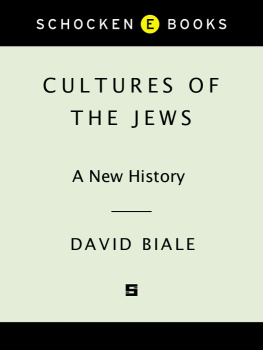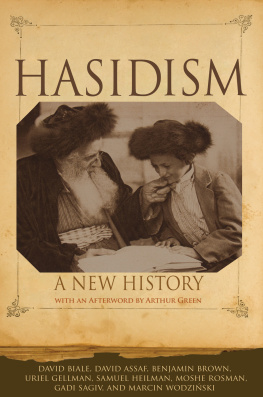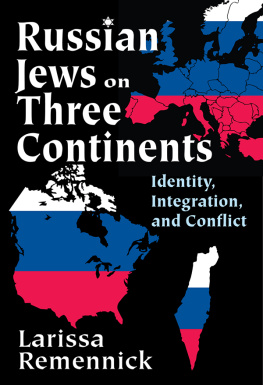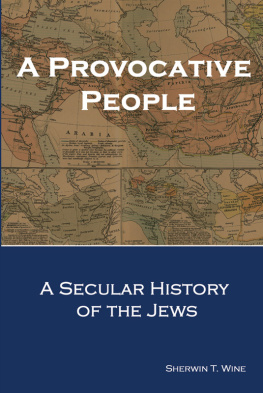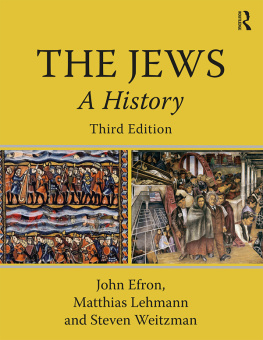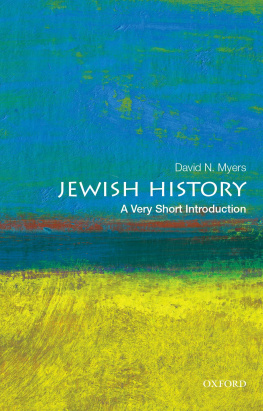ACKNOWLEDGMENTS
The contributors to this work deserve the greatest thanks, not only for their own contributions but also for serving as equal partners with the editor, assisting in the selection of other contributors, and making invaluable suggestions to improve the work as a whole. Meeting twice as the project evolvedonce in Berkeley at an early stage and later in Jerusalemthe authors read and criticized one anothers chapters in a quest to find common ground without stifling individual voices. Rare it is in the humanistic disciplines that scholars, instead of working in isolation, come together for a shared purpose.
A special session at the 2001 World Congress of Jewish Studies in Jerusalem, organized at the initiative of Moshe Rosman, produced a lively debate over the works governing hypotheses about Jewish culture. In the context of that session, Moshes perceptive and critical reading of my general introduction contributed greatly toward refining that portion of the manuscript.
The origins of this work go back to a telephone conversation in 1995 with Arthur Samuelson, then the editor-in-chief of Schocken Books. Together, we developed the basic outlines of the project. Arthur participated as a full equal in the first conference of contributors and made a signal contribution by encouraging the authors to envision an audience beyond the academy. Arthur was succeeded some years later by Susan Ralston, who played no less important an editorial role. Susan entered the scene as the contributors submitted their chapters and her razor-sharp editors pencil turned academic prose into much more accessible writing. Her advice, support, and good humor were indispensable in producing a coherent book from what had been piles of pages.
The members of the Editorial Advisory Board, whose names are listed elsewhere in this book, made many useful suggestions at different stages of the projects development. Two of them, William Brinner and Steven Zipperstein, deserve to be singled out for contributions beyond the call of duty, including reading and commenting on some of the chapters.
Abe Socher served as the projects editorial assistant and made many valuable comments on early drafts of chapters. Joe Socher did yeomans duty as source checker. Julia Johnson Zafferanos careful copyediting assured consistency in spelling and style throughout the manuscript. Dassi Zeidel, at Schocken, coordinated much of the project, including the collection of illustrations. Susan Smith and Kathleen van Sickle deserve special thanks for their assistance in preparing the manuscripts. Carol Cosman translated Lucette Valensis chapter from French, Murray Rosovsky translated Yosef Tobis from Hebrew, and Azzan Yadin translated Ariel Hirschfelds chapter, also from Hebrew.
Two foundations supported this work. The Koret Foundation of San Francisco helped underwrite the conferences that brought the contributors together. The Maurice Amado Foundation of Los Angeles subsidized the chapters on Sephardic, North African, and Middle Eastern Jewish cultures.
DAVID BIALE
January 2002
ABOUT THE EDITOR
David Biale is the Emmanuel Ringelblum Professor of Jewish History at the University of California, Davis. He is the author of Power and Powerlessness in Jewish History and the editor of Insider/Outsider: American Jews and Multiculturalism. He lives in Berkeley, California.
EDITORIAL ADVISORY BOARD
ROBERT ALTER , University of California, Berkeley
WILLIAM BRINNER , University of California, Berkeley
NATALIE DAVIS , Princeton University
WENDY DONIGER , University of Chicago
CARLO GINZBURG , University of California, Los Angeles, and University of Bologna
STEPHEN GREENBLATT , Harvard University
MOSHE HALBERTAL , The Hebrew University of Jerusalem
GALIT HASAN-ROKEM , The Hebrew University of Jerusalem
MOSHE IDEL , Hebrew University
BARBARA KIRSCHENBLATT-GIMBLETT , New York University
CHANA KRONFELD , University of California, Berkeley
BERNARD LEWIS , Princeton University
GEORGE MOSSE , University of Wisconsin (deceased)
DAVID SORKIN , University of Wisconsin
FROMA ZEITLIN , Princeton University
STEVEN ZIPPERSTEIN , Stanford University
INTRODUCTION TO PART ONE: MEDITERRANEAN ORIGINS

DAVID BIALE
When and where does the first Jewish culture begin? Two deceptively simple questions whose answers remain shrouded in the mists of ancient Near Eastern history. Our sources are the Hebrew Bible and archaeological evidence, but these sources raise as many questions as they answer. The earliest mention of ancient Israel appears on a stele or victory monument of the PharaohMerneptah in the second half of the thirteenth century B.C.E. There the pharaoh boasts: Israel is laid waste, his seed is no more. An inauspicious beginning for a people that was to last over three millennia after their proclaimed extermination! From this point on, the archaeological record becomes murky: we possess no external evidence of the Exodus from Egypt and ambiguous evidencefor the subsequent conquest of Canaan. The archaeologists tell us that the material culture of ancient Israel differed little, if at all, from that of the Canaanites who inhabited the coastal plain; some have concluded that the Israelites were Canaanites who lived in the hill country between the Jordan River and the Mediterranean. According to this hotly contested opinion, the Exodus was a myth, because the Israelites never left the Land of Canaan.
And what of the Bible, which tells the familiar story of Abraham, whom God commands to leave Ur of the Chaldeans and go to the land of the Canaanites, whose possession he is promised? Does this mean that the children of Israel, as they would later call themselves after the second name of Abrahams grandson, Jacob, originated in the fertile plains of Mesopotamia? The stories of the three patriarchs and their four wivescertainly suggest such a connection. But then the Bible offers contradictory evidence. A gap of 400 (or, in another tradition, 430) years separates the Genesis stories from the emergence of the Israelite nation from slavery in Egypt. Why does the book that the Israelites themselves wrotebased, no doubt, on ancient traditionscontain no trace of memory for such a long period? Could it be that the stories of the patriarchs and matriarchs wereindependent tales added later to give a new and, even worse, a slave nation some venerable antiquity? The Exodus story itself admits that the nation left Egypt as a mixed multitude (Exodus 12:38), the very opposite of an ethnic or tribal group with a common lineage. Much later, the prophet Ezekiel would thunder: By origin and birth you are from the land of the Canaanitesyour father was an Amorite and youre a Hittite (Ezekiel 16:3).
These texts raise as many questions as do the archaeologists. Why would a nation preserve as canonical admissions of such a tainted genealogy? If the Exodus was a myth, why would a nation invent such a disreputable story of slave origins? If all nations are imagined communities, ancient Israel has left us evidence of a very conflicted imagination. Certain real historical events may well underlie what some dismiss as literary myth. History and literature cannotbe so easily separated.
If, additionally, a culture is determined by the borders between us and them, the culture of biblical Israel was very poorly defended, because, even as the nation was commanded to eradicate its neighbors (you must doom them to destruction: grant them no terms and give them no quarterDeuteronomy 7:2), both persons and ideas from those neighborspersistently appear and reappear in the Bible. An example is Uriah the Hittite, Davids general and the first husband of Bathsheba, who, once David had Uriah killed in battle, became Davids wife and was the mother of King Solomon. What was a Hittite doing as a general in Davids army if, as Deuteronomy 7prescribes, the Hittites should have been exterminated? Why does he have a name that suggests that he worships the God of Israel? And David himself, the great-grandson of a Moabite woman, would also, according to a Deuteronomic law, have been forbidden to enter the assembly of God. These examples suggest that the boundaries between Israelites and non-Israelites in the Land of Canaan were evidently much fuzzier than we have traditionallybelieved. Categories of ethnicity and religion may have meant something very different then than they mean to us now.

